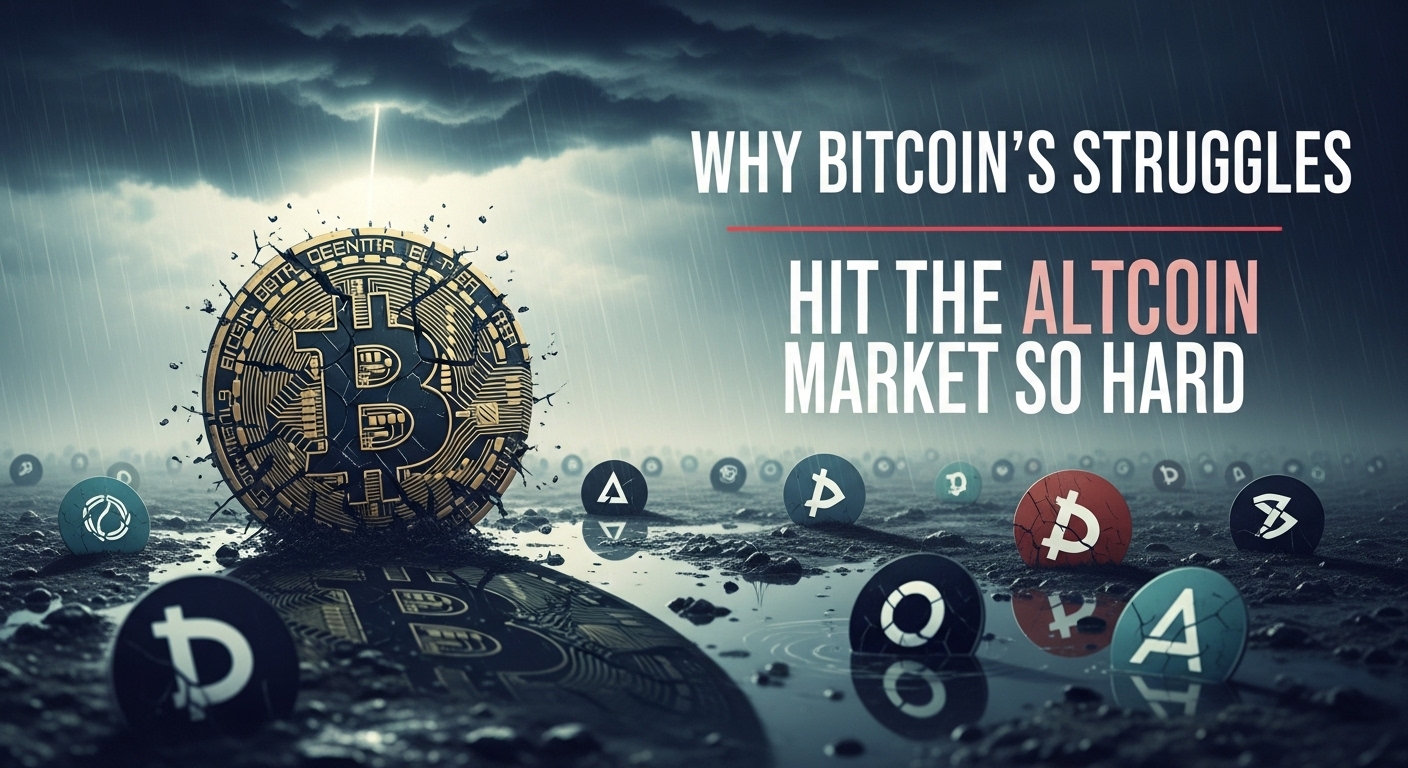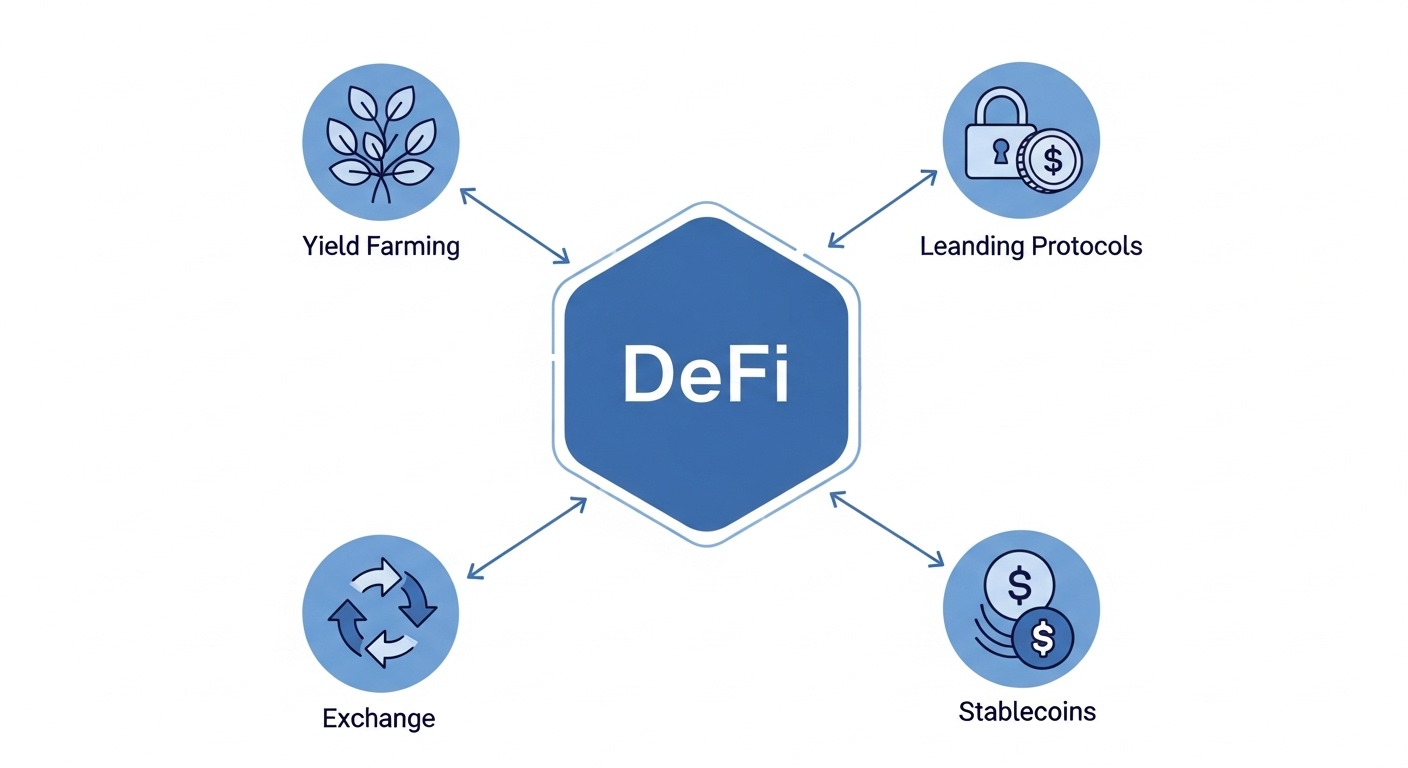Altcoin Market Faces Turbulence as Bitcoin Struggles
Altcoin market faces turbulence as Bitcoin struggles, reshaping crypto trends. Explore risks, opportunities, and smart strategies in today’s volatile cycle.

The phrase “Altcoin Market Faces Turbulence as Bitcoin Struggles” captures the mood across the broader crypto landscape. After periods of euphoric rallies and rapid gains, traders are now confronting sharp pullbacks, sudden liquidity gaps, and unpredictable sentiment shifts. As Bitcoin fails to deliver a clear, sustained uptrend, many alternative cryptocurrencies are experiencing amplified volatility, steep drawdowns, and aggressive cycles of fear and greed.
This environment is not entirely new. Crypto market volatility has always been a core feature of digital assets, but the current phase feels different because it comes after years of maturation, institutional interest, and technological progress. Investors who expected a smooth path to adoption are now reminded that even in a more developed market, Bitcoin price struggles can reverberate through every corner of the ecosystem, from blue-chip altcoins to speculative microcaps.
The Evolving Crypto Landscape: From Euphoria to Uncertainty
Over the last several years, the cryptocurrency market has evolved from an experimental niche into a globally recognized asset class. Major institutions now monitor Bitcoin market cycles, regulators actively debate frameworks, and retail investors are more educated than in previous bull runs. Yet, despite this progress, the pattern remains familiar: rapid expansions followed by intense corrections.
When Bitcoin struggles to maintain momentum, capital tends to rotate cautiously rather than aggressively. In earlier cycles, a dip in Bitcoin would sometimes fuel speculative rotations into altcoins, driving temporary “alt-season” rallies. Today, however, macroeconomic uncertainty, regulatory scrutiny, and risk-sensitive institutional flows mean that weakness in Bitcoin often triggers a broad de-risking across the board.
As a result, the altcoin market faces turbulence as Bitcoin struggles, not only in price but also in sentiment. Projects that once enjoyed enthusiastic communities and strong price support now face questions about sustainability, tokenomics, and real-world adoption. This shift from narrative-driven valuations to more fundamental scrutiny intensifies volatility, as markets constantly reassess which projects can endure prolonged stress.
Why Bitcoin’s Struggles Hit the Altcoin Market So Hard

Bitcoin’s Role as the Crypto Benchmark
Bitcoin remains the reference point for the entire digital asset ecosystem. Its market dominance, liquidity, and institutional acceptance make it the primary barometer of risk appetite in crypto. When Bitcoin struggles to hold key support levels or fails to break important resistance zones, traders interpret it as a sign that the overall crypto bull market is either pausing or losing strength.
This dynamic cascades into altcoins in several ways. Many traders measure performance against Bitcoin pairs, and when BTC is unstable, they often cut risk by selling altcoins first. This leads to sharper declines in altcoin prices, reinforcing the narrative that the altcoin market faces turbulence as Bitcoin struggles to find a clear direction.
Macro Headwinds and Risk-Off Sentiment
Crypto does not operate in a vacuum. High inflation, interest-rate uncertainty, geopolitical tensions, and changes in global liquidity all impact investor behavior. In a risk-off environment, speculative assets like altcoins are usually the first to be reduced or exited. While Bitcoin may retain some appeal as “digital gold” or a long-term hedge for believers, smaller altcoins are rarely viewed as safe havens.
This macro backdrop creates a scenario where Bitcoin holding flat or making modest moves is not enough to support the risk-on enthusiasm needed for a robust altcoin rally. Instead, each Bitcoin pullback can trigger outsized reactions in altcoins, deepening the perception that the altcoin market is in turmoil whenever Bitcoin price action looks fragile.
Liquidity Concentration and Exchange Dynamics
Another reason the altcoin market faces turbulence as Bitcoin struggles is the concentration of liquidity. The deepest order books are still centered around Bitcoin and a handful of large-cap altcoins. When trading volumes shrink or shift toward safer assets, smaller altcoins can experience wide spreads and sudden price gaps.
In thinly traded markets, a relatively modest sell order can trigger cascading liquidations, especially when many participants are using leverage. This is why altcoin market volatility can be extreme in phases where Bitcoin is merely range-bound or mildly bearish. The lack of stable, robust liquidity magnifies the impact of every sentiment shift.
How Turbulence Manifests Across the Altcoin Market
Sharp Rotations Between Large-Cap and Small-Cap Altcoins
One visible effect when the altcoin market faces turbulence as Bitcoin struggles is the fast rotation of capital between different segments of the market. Large-cap altcoins like Ethereum, Solana, or XRP may temporarily outperform as traders seek relative safety outside of Bitcoin. However, if BTC weakness persists, even these stronger names can face heavy corrections.
Small-cap and microcap coins, especially those driven by hype, memes, or short-lived narratives, often suffer the most intense drawdowns. The same crypto assets that soared during bullish sentiment can lose substantial value within days or weeks when the tide turns. Without the cushion of deep liquidity or established fundamentals, many speculative coins become extremely vulnerable.
Divergence Between Fundamentals and Price
Another hallmark of turbulence is the divergence between technological progress and market pricing. Some projects continue to ship upgrades, expand partnerships, and build communities even as their tokens trend lower. In other cases, coins with minimal development activity may hold value purely through speculative or community-driven momentum.
This disconnect makes it harder for investors to rely on short-term price action as a signal of long-term viability. The altcoin market becomes a complex puzzle, where Bitcoin’s struggles set the tone but individual performance depends on a blend of fundamentals, token economics, and narrative strength. This environment rewards deeper research and punishes blind speculation.
Sector-by-Sector Impact: DeFi, NFTs, and Layer-1 Blockchains

DeFi Tokens Under Pressure
The decentralized finance (DeFi) sector has been one of the most innovative areas in crypto, enabling lending, borrowing, yield farming, and decentralized trading. Yet DeFi tokens are still highly sensitive to shifts in Bitcoin price trends and broader risk appetite. When users pull liquidity from protocols or unwind leveraged positions, DeFi token prices can fall quickly.
As the altcoin market faces turbulence as Bitcoin struggles, DeFi protocols must prove that they can maintain security, capital efficiency, and competitive yields without relying purely on speculative inflows. Projects with sustainable fee models, real user activity, and robust governance stand a better chance of enduring prolonged volatility, while weaker platforms may fade from relevance.
NFT and Metaverse Coins in a Reality Check
The boom in NFTs and metaverse tokens brought a wave of new users and creative experimentation. However, these assets are among the most vulnerable when markets pivot from hype to caution. Collections that once commanded high floor prices may see demand evaporate as traders re-evaluate which digital collectibles have lasting cultural or utility value.
Similarly, tokens connected to virtual worlds, gaming platforms, or digital identity ecosystems are under pressure to demonstrate real engagement and adoption. In a phase where the altcoin market faces turbulence as Bitcoin struggles, speculative narratives alone are not enough. Teams must show tangible progress, player retention, and compelling experiences to justify their valuations.
Layer-1 and Layer-2 Competition Intensifies
The competition between Layer-1 blockchains (like Ethereum alternatives) and Layer-2 scaling solutions is another important storyline in the current cycle. In bull markets, capital flows freely to multiple chains, and users are more willing to experiment. In turbulent conditions, however, attention tends to consolidate around ecosystems with proven security, developer activity, and user base.
When Bitcoin is struggling and the broader market is cautious, investors scrutinize altcoin projects claiming to be “Ethereum killers” or revolutionary new base layers. Network uptime, transaction costs, developer tools, and ecosystem incentives all come under the microscope. Only a subset of networks emerges stronger, while others lose liquidity and fade into low-volume obscurity.
Investor Psychology in a Turbulent Altcoin Cycle
Fear, Greed, and the Emotional Cycle
Human psychology plays a huge role in why the altcoin market faces turbulence as Bitcoin struggles. Rapid price declines can trigger panic selling, while sharp relief rallies inspire renewed hope that the worst is over. This emotional cycle can repeat multiple times in a single market phase, making it difficult for traders to maintain objectivity.
Indicators like crypto fear and greed indices, social media sentiment, and funding rates often swing quickly. During severe drawdowns, many participants capitulate at or near the bottom, only to watch prices recover later. Conversely, chasing parabolic moves during short-lived rallies can result in buying the top of local spikes. Understanding this psychological pattern is crucial for navigating the market more rationally.
The Illusion of “Easy Money”
In the previous bull cycles, stories of overnight millionaires and spectacular meme coin gains created the impression that altcoin investing was an easy path to wealth. When the altcoin market faces turbulence as Bitcoin struggles, this illusion is shattered. Traders who were overexposed or depended on unrealistic returns may face harsh lessons about risk management and diversification.
Recognizing that volatility cuts both ways is essential. The same leverage and liquidity that drive explosive upside can accelerate losses. The current environment reminds participants that risk-adjusted returns, capital preservation, and time-tested strategies matter more than chasing the latest trending token.
Practical Strategies for Navigating Altcoin Turbulence
Focus on Risk Management and Position Sizing
One of the most effective ways to handle a period where the altcoin market faces turbulence as Bitcoin struggles is to prioritize risk management. Rather than aiming for maximum exposure, investors can size positions conservatively, diversify across sectors, and avoid excessive leverage.
Using clear invalidation points, such as technical levels or fundamental milestones, helps investors define risk ahead of time. This approach prevents emotional decision-making during sharp drawdowns and reduces the chance of catastrophic portfolio damage. In a highly volatile environment, surviving the downturn is often more important than maximizing short-term gains.
Emphasize Fundamentals Over Hype
In choppy markets, the gap widens between speculative narratives and genuine value. Projects with strong teams, active communities, clear use cases, and transparent tokenomics are better positioned to recover once confidence returns. Evaluating on-chain activity, development updates, and real-world integrations can reveal which altcoins have staying power.
Instead of chasing every new meme coin or trend, investors can build a watchlist of fundamentally sound projects and accumulate gradually when valuations become compelling. Over time, this disciplined approach tends to outperform purely momentum-driven strategies, especially in phases where Bitcoin’s struggles undermine broad speculative excess.
Maintain a Long-Term Perspective
Crypto markets have historically moved in multi-year cycles. Periods of euphoria are followed by consolidation and occasionally deep bear markets. Recognizing that the current phase, where the altcoin market faces turbulence as Bitcoin struggles, is part of a larger cycle can help investors maintain perspective.
Long-term conviction does not mean ignoring risk; it means aligning time horizons with the underlying thesis. If an investor believes in the structural growth of blockchain technology, decentralized finance, or digital ownership, then temporary turbulence becomes an opportunity to accumulate quality assets at more attractive prices, rather than a signal to abandon the entire space.
See More: Crypto Market Crash Why Bitcoin & Altcoins Are Falling
Opportunities Hidden in the Chaos
Accumulation Phases and Value Discovery
Historically, many of the best opportunities in crypto have appeared when sentiment was at its worst. When the altcoin market faces turbulence as Bitcoin struggles, valuations can fall to levels that price in extreme pessimism. For disciplined investors, these moments can provide entry points that are not available during hype-driven rallies.
This does not mean every beaten-down coin will recover. Instead, it highlights the importance of selective accumulation. By focusing on projects with strong fundamentals, genuine innovation, and resilient communities, investors can turn market fear into a strategic advantage and position themselves for the next sustained uptrend.
Innovation Continues Behind the Scenes
Even as prices drop, builders keep building. New protocols, scaling solutions, and real-world integrations continue to emerge across the crypto ecosystem. The public narrative may focus on price turbulence, but under the surface, progress in areas like Layer-2 scaling, cross-chain interoperability, decentralized identity, and real-world asset tokenization is ongoing.
This disconnect between innovation and short-term price action is one of the reasons the altcoin market, despite current turbulence, continues to attract long-term believers. Once Bitcoin stabilizes and market conditions improve, projects that spent downturns shipping code and refining their products are often the first to regain momentum.
What Could Stabilize the Altcoin Market?
A Clearer Direction for Bitcoin
Since the altcoin market faces turbulence as Bitcoin struggles, any meaningful recovery will likely start with Bitcoin itself. A decisive breakout from prolonged ranges, renewed institutional inflows, or a shift in macro conditions that favors risk assets could provide the foundation for a healthier crypto environment.
When Bitcoin demonstrates resilience and forms a convincing uptrend, confidence spreads through the market. Under such conditions, investors are more willing to allocate capital to altcoins, especially those with compelling narratives and strong fundamentals.
Regulatory Clarity and Institutional Adoption
Regulatory uncertainty has been a persistent source of volatility. Clearer guidelines, fair classification of different token types, and supportive frameworks for innovation could reduce fear and encourage responsible participation from larger institutions. As more regulated financial products and custody solutions emerge, the perception of crypto as a legitimate asset class strengthens.
In turn, this can stabilize flows into both Bitcoin and altcoins, reducing the wild swings that define earlier cycles. While regulation may impose constraints, it can also provide guardrails that increase trust and unlock new sources of capital.
Maturing Market Infrastructure
Finally, improvements in market infrastructure—such as better risk controls on exchanges, enhanced transparency, more robust derivatives markets, and institutional-grade custodial services—can help moderate extreme volatility. As tools for hedging, portfolio management, and compliance evolve, the ecosystem becomes more attractive for sophisticated participants who value risk control as much as potential returns.
When these elements come together, the current phase where the altcoin market faces turbulence as Bitcoin struggles could eventually give way to a more stable, liquid, and efficient environment. In such a setting, price discovery becomes more rational, and short-term noise has less ability to distort long-term value.
Conclusion
The reality that the altcoin market faces turbulence as Bitcoin struggles is undeniable, but turbulence is not the same as collapse. Volatility has always been part of the crypto story, and each cycle teaches new lessons about risk, conviction, and the importance of fundamentals.
Investors who acknowledge Bitcoin’s central role, understand macro influences, and recognize the sector-specific impacts on DeFi, NFTs, and Layer-1 ecosystems can navigate this phase with greater clarity. By emphasizing risk management, focusing on projects with real utility, and maintaining a long-term perspective, traders and investors can transform a chaotic environment into a landscape of opportunity.
As the market matures, the relationship between Bitcoin and the broader altcoin universe will continue to evolve. For now, however, the health of the crypto ecosystem still begins with Bitcoin. Until it finds stronger footing, the altcoin market will likely remain choppy, offering both significant risks and potential rewards for those prepared to handle the ride.



